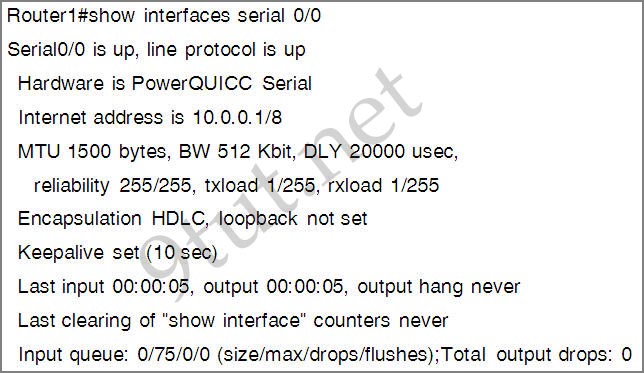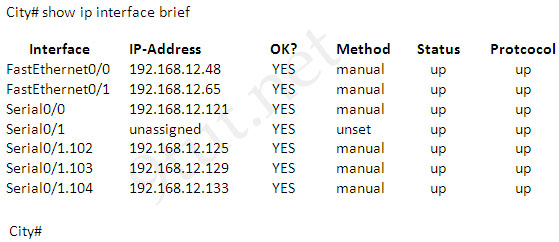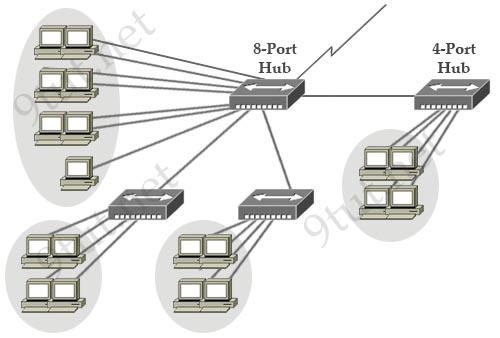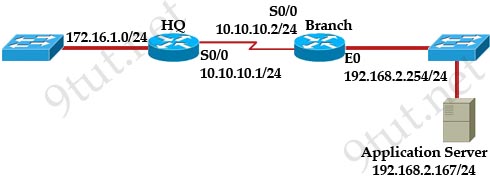ICND1 – Basic Questions
[am4show have=’p2;’]
Premium Member: You can test your knowledge with these questions first via this link.
[/am4show]
Question 1
[am4show have=’p2;’]Which two statements describe the operation of the CSMA/CD access method? (Choose two)
A. In a CSMA/CD collision domain, multiple stations can successfully transmit data simultaneously.
B. In a CSMA/CD collision domain, stations must wait until the media is not in use before transmitting.
C. The use of hubs to enlarge the size of collision domains is one way to improve the operation of the CSMA/CD access method.
D. After a collision, the station that detected the collision has first priority to resend the lost data.
E. After a collision, all stations run a random backoff algorithm. When the backoff delay period has expired, all stations have equal priority to transmit data.
F. After a collision, all stations involved run an identical backoff algorithm and then synchronize with each other prior to transmitting data.
Answer: B E[/am4show]
Explanation
CSMA/CD stands for Carrier Sense Multiple Access with Collision Detection. In an Ethernet LAN, before transmitting, a computer first listens to the network media. If the media is idle, the computer sends its data. If the media is not idle (another station is talking), the computer must wait for some time.
When a station transmits, the signal is referred to as a carrier. Carrier Sense means that before a station can send data onto an Ethernet wire, it have to listen to see if another “carrier” (of another station) is present. If another station is talking, this station will wait until there is no carrier present.
Multiple Access means that stations can access the network at any time. It is opposed to Token-Ring network where a station must have the “token” so that it can send data.
Although Carrier Sense help two stations not send data at the same time but sometimes two stations still send data at the same time! This is because two stations listen for network traffic, hear none, and transmit simultaneously -> a collision occurs and both stations must retransmit at some later time. Collision Detection is the ability of the media to detect collisions to know that they must retransmit.
Basically, the CSMA/CD algorithm can be summarized as follows:
+ A device that wants to send a frame must wait until the LAN is silent (no one is “talking”)
+ If a collision still occurs, the devices that caused the collision wait a random amount of time and then try to send data again.
Note: A switch separates each station into its own collision domain. It means that station can send data without worrying its data is collided with the data of other stations. It is as opposed to a hub which can cause collision between stations connected to it.
Question 2
[am4show have=’p2;’]On a live network, which commands will verify the operational status of router interfaces? (Choose two)
A. Router#show interfaces
B. Router#show ip protocols
C. Router#debug interface
D. Router#show ip interface brief
E. Router#show start
Answer: A D[/am4show]
Explanation
Only two commands “show interfaces” and “show ip interface brief” reveal the status of router interfaces (up/up, for example).
The outputs of two commands are shown below:


Question 3
[am4show have=’p2;’]What must occur before a workstation can exchange HTTP packets with a web server?
A. A UDP connection must be established between the workstation and its default gateway.
B. A UDP connection must be established between the workstation and the web server.
C. A TCP connection must be established between the workstation and its default gateway.
D. A TCP connection must be established between the workstation and the web server.
E. An ICMP connection must be established between the workstation and its default gateway.
F. An ICMP connection must be established between the workstation and the web sewer.
Answer: D[/am4show]
Explanation
HTTP is based on TCP connection so a TCP connection must be established first between the workstation and the web server.
Question 4
[am4show have=’p2;’]Refer to the exhibit. If the hubs in the graphic were replaced by switches, what would be virtually eliminated?

A. broadcast domains
B. repeater domains
C. Ethernet collisions
D. signal amplification
E. Ethernet broadcasts
Answer: C[/am4show]
Explanation
Hubs do not separate collision domains so if hub is used in the topology above, we will have only 1 collision domain. Switches do separate collision domains so if hubs are replaced by switches, we would have 22 collision domains (19 collision domains for hosts and 3 collision domains among three switches. Please notice that the WAN (serial) connection is not counted as a collision (or broadcast) domain.
Question 5
[am4show have=’p2;’]If a host experiences intermittent issues that relate to congestion within a network while remaining connected, what could cause congestion on this LAN?
A. half-duplex operation
B. broadcast storms
C. network segmentation
D. multicasting
Answer: B[/am4show]
Explanation
A broadcast storm can cause congestion within a network. For more information about broadcast storm please read my STP tutorial.
Question 6
[am4show have=’p2;’]Refer to the exhibit. The network administrator is testing connectivity from the branch router to the newly installed application server. What is the most likely reason for the first ping having a success rate of only 60 percent?

|
Branch# ping 192.168.2.167 Branch# ping 192.168.2.167 |
A. The network is likely to be congested, with the result that packets are being intermittently dropped.
B. The branch router had to resolve the application server MAC address.
C. There is a short delay while NAT translates the server IP address.
D. A routing table lookup delayed forwarding on the first two ping packets.
E. The branch router LAN interface should be upgraded to FastEthernet.
Answer: B[/am4show]
Explanation
Before a host can send ICMP (ping) packets to another device, it needs to learn the MAC address of the destination device so it first sends out an ARP Request. In fact, the first ping packet is dropped because the router cannot create a complete packet without learning the destination MAC address.
Question 7
[am4show have=’p2;’]An administrator is in the process of changing the configuration of a router. What command will allow the administrator to check the changes that have been made prior to saving the new configuration?
A. Router# show startup-config
B. Router# show current-config
C. Router# show running-config
D. Router# show memory
E. Router# show flash
F. Router# show processes
Answer: C[/am4show]
Explanation
The “show running-config” command displays active configuration in memory.
Question 8
[am4show have=’p2;’]What does a host on an Ethernet network do when it is creating a frame and it does not have the destination address?
A. drops the frame
B. sends out a Layer 3 broadcast message
C. sends a message to the router requesting the address
D. sends out an ARP request with the destination IP address
Answer: D[/am4show]
Question 9
[am4show have=’p2;’]Which IOS command is used to initiate a login into a VTY port on a remote router?
A. router# login
B. router# telnet
C. router# trace
D. router# ping
E. router(config)# line vty 0 5
F. router(config-line)# login
Answer: B[/am4show]
Question 10
[am4show have=’p2;’]Which three statements are true about the operation of a full-duplex Ethernet network? (Choose three)
A. There are no collisions in full-duplex mode.
B. A dedicated switch port is required for each full-duplex node.
C. Ethernet hub ports are preconfigured for full-duplex mode.
D. In a full-duplex environment, the host network card must check for the availability of the network media before transmitting.
E. The host network card and the switch port must be capable of operating in full-duplex mode.
Answer: A B E[/am4show]
Explanation
Full-duplex communication allows both sending and receiving of data simultaneously. Switches provide full-duplex communication capability. Half-duplex communication only allows data transmission in only one direction at a time (either sending or receiving).


Really need to do the CCNA before the new one released. Can someone help with some dumps? @ adeel samsung44 @ gmail com . **
Would someone be able to send me the ICND 1 dump? I would really appreciate it.
troublesumlu @ gmail .com
Can someone please send me the latest dump
Mnmkiki9 @ gmail . Com
Hey everyone,
Could anyone please send me the latest INCD 1 & 2 Dumps. That would be greatly appreciated.
Email pinchukctac (@) gmail .com
can someone send me the latest dumps? I would really appreciate it
steffano.matt @ yahoo .com
I’m trying to get my CCNA before the new exam comes out next month. Any one have recent dumps they can share. griveraits at gmail dot com.
Hey everyone,
Take the test on Friday!
Could anyone please send me the latest INCD 1 & 2 Dumps. That would be greatly appreciated.
Email kel_net (@) hotmail.com
My email is victoryatanga@gmail
Please help me out with valid dumps I need this soo urgently
Thanks